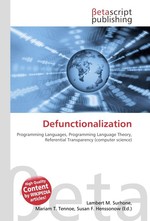Defunctionalization
Lambert M. Surhone, Mariam T. Tennoe, Susan F. Henssonow
бумажная книга
Please note that the content of this book primarily consists of articles available from Wikipedia or other free sources online. In programming languages, defunctionalization refers to a compile-time transformation which eliminates higher-order functions, replacing them by a single first-order apply function. The technique was first described by John C. Reynolds in his 1972 paper, "Definitional Interpreters for Higher-Order Programming Languages". Reynolds' observation was that a given program contains only finitely many function abstractions, so that each can be assigned (and replaced by) a unique identifier. Every function application within the program is then replaced by a call to the apply function with the function identifier as the first argument. The apply function's only job is to dispatch on this first argument, and then perform the instructions denoted by the function identifier on the remaining arguments.
Данное издание не является оригинальным. Книга печатается по технологии принт-он-деманд после получения заказа.


